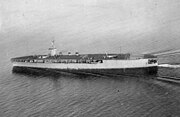Naval history of Japan
| Part ofa serieson the |
| History of Japan |
|---|
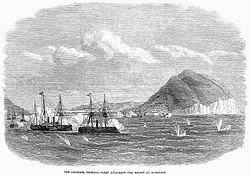 |
Thenaval history of Japanbegan with early interactions with states on the Asian continent in the 3rd century BCE during theYayoi period.It reached a pre-modern peak of activity during the 16th century, a time ofcultural exchange with European powersand extensive trade with the Asian continent. After over two centuries of self-imposedseclusionunder theTokugawa shogunate,Japan's naval technologies became outdated compared to Western navies. The country was forced to abandon its maritime restrictions by American intervention with thePerry Expeditionin 1854. This and other events led to theMeiji Restoration,a period of frantic modernization and industrialization accompanied by the re-ascendance of theEmperor's rule andcolonialismwith theEmpire of Japan.Japan became the first industrialized Asian country in 1868, by 1920 theImperial Japanese Navywas the third largest navy in the world and arguably the most modern at the brink ofWorld War II.
The Imperial Japanese Navy had a history of successes, sometimes against much more powerful foes as in the 1894–1895Sino-Japanese War,the 1904–1905Russo-Japanese War,and early naval battles duringWorld War II.In 1945, towards the end of the conflict, the navy was almost completely destroyed by theUnited States Navy.Japan's current navy is a branch of theJapan Self-Defense Forces(JSDF) called theJapan Maritime Self-Defense Force(JMSDF). In 2015, the JMSDF was ranked byCredit Suisseas the fourth most powerful military in the world.[1]However, it is still denied any offensive role by the nation's post-warConstitutionand public opinion.
Prehistory[edit]
Japan was connected to the Asian continent via land during theglacial maximumof thelast ice agearound 20,000 BCE.[2]This allowed for the transmission of flora and fauna, including the establishment of theJōmonculture. The land bridges disappeared in theJōmon periodaround 10,000 BCE.[2]After that period however, Japan became an isolated island territory, depending entirely on sporadic naval activity for its interactions with the continent. The shortest seapath to the continent (besides the inhospitable northern path fromHokkaidōtoSakhalin) then involved two stretches of open water about 50 kilometers wide, between theKorean peninsulaand the island ofTsushima,and then from Tsushima to the major island ofKyūshū.
Early historical period[edit]
Ambassadorial visits to Japan by the later Northern Chinese dynastiesWeiandJin(Encounters of the Eastern Barbarians,Wei Chronicles) recorded that some Japanese people claimed to be descendants ofTaibo of Wu,refugees after the fall of the Wu state in the 5th century BCE. History books do have records of Wu Taibo sending 4000 males and 4000 females to Japan.[5]
Yayoi Period[edit]
The first major naval contacts occurred in theYayoi periodin the 3rd century BCE, when rice-farming andmetallurgywere introduced, from the continent.
The 14 AD incursion ofSilla( tân la,Shiragiin Japanese), one of theThree Kingdoms of Korea,is the earliest Japanese military action recorded inSamguk Sagi.According to that record,Wa(the proto-Japanese nation) sent one hundred ships and led an incursion on the coastal area of Silla before being driven off.
Yamato Period[edit]
During theYamato period,Japan had intense naval interaction with the Asian continent, largely centered around diplomacy and trade with China, the Korean kingdoms, and other continental states, since at latest the beginning of theKofun periodin the 3rd century. According to a mythological account in theKojikiandNihon Shoki,Empress Jingūis claimed to have invaded Korea in the 3rd century, and to have returned victorious after three years. Whether a Japanese political entity actually ruled a part of Korea in ancient times is debated, but considered unlikely for that time period.[3]
Other than the expedition of Empress Jingū,battle of Hakusukinoe( bạch thôn giang ), one of the earliest historical events in Japan's naval history took place in 663. Japan sent 32,000 troops and possibly as many as 1,000 ships to Korea to support the decliningBaekjekingdom ( trăm tế quốc; contemporary records suggest that Baekje and Yamato Japan were allies, and that their royal/imperial families were possibly related) against Silla andTang-dynastyChina. They were defeated by the T'ang-Silla combined force.
TheAzumi peoplewere a warrior tribe from northernKyushu.[4]They were extremely skilled seafarers.[5]The Azumi gained early contact with the Yamato Court and provided maritime trade links and influenced the Yamato Court's military and diplomatic approach in the seas.[5]Thus the Japanese imperial government employed them as their naval force from the 3rd to 5th centuries.[6][7]
Medieval period[edit]

Naval battles of a very large scale, fought between Japanese clans and involving more than 1000 warships, are recorded from the 12th century. The decisive battle of theGenpei War,and one of the most famous and important naval battles in pre-modern Japanese history, was the 1185battle of Dan-no-ura,which was fought between the fleets of theMinamotoandTairaclans. These battles consisted first of long-range archery exchanges, then giving way to hand-to-hand combat with swords and daggers. Ships were used largely as floating platforms for what were largely land-based melee tactics.
Mongol invasions (1274–1281)[edit]

The first major references to Japanese naval actions against other Asian powers occur in the accounts of theMongol invasions of JapanbyKublai Khanin 1281. Japan had no navy which could seriously challenge the Mongol navy, so most of the action took place on Japanese land. Groups ofsamurai,transported on small coastal boats, are recorded to have boarded, taken over and burned several ships of the Mongol navy.
Wakō piracy (13th–16th century)[edit]
During the following centuries,wakōpirates actively plundered the coast of theChinese Empire.Though the termwakōtranslates directly to "Japanese pirates", Japanese were far from the only sailors to harass shipping and ports in China and other parts of Asia in this period, and the term thus more accurately includes non-Japanese pirates as well. The first raid bywakōon record occurred in the summer of 1223, on the south coast ofGoryeo.At the peak ofwakōactivity around the end of the 14th century, fleets of 300 to 500 ships, transporting several hundred horsemen and several thousand soldiers, would raid the coast of China[6].For the next half-century, sailing principally fromIki IslandandTsushima,they engulfed coastal regions of the southern half of Goryeo. Between 1376 and 1385, no fewer than 174 instances of pirate raids were recorded in Korea. However, whenJoseondynasty was founded in Korea,wakōtook a massive hit in one of their main homeland of Tsushima during theŌei Invasion.The peak ofwakōactivity was during the 1550s, when tens of thousands of pirates raided the Chinese coast in what is called theJiajingwakōraids,but thewakōat this time were mostly Chinese.Wakōpiracy ended for the most part in the 1580s with its interdiction byToyotomi Hideyoshi.
Official trading missions, such as theTenryūji-bune,were also sent to China around 1341.
Sengoku period (15th–16th century)[edit]


Variousdaimyōclans undertook major naval building efforts in the 16th century, during theSengoku period,when feudal rulers vying for supremacy built vast coastal navies of several hundred ships. The largest of these ships were calledatakebune.Around that time, Japan seems to have developed one of the firstironcladwarships in history, whenOda Nobunaga,a Japanesedaimyō,had six iron-coveredŌ-atakebune( "Great Atakebune" ) made in 1576[7].These ships were calledtekkōsen(Thiết giáp thuyền),literally "iron armored ships", and were armed with multiple cannons and large caliber rifles to defeat the large, but all wooden, vessels of the enemy. With these ships, Nobunaga defeated theMōri clannavy at the mouth of the Kizu River, nearOsakain 1578, and began a successful naval blockade. TheŌ-atakebuneare regarded as floating fortresses rather than true warships, however, and were only used in coastal actions.
European contacts[edit]
This sectionmay contain materialnot related to the topic of the article.(August 2016) |
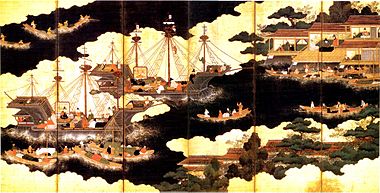
The first Europeans reached Japan in 1543 on Chinesejunks,and Portuguese ships started to arrive in Japan soon after. At that time, there was already trade exchanges between Portugal andGoa(since around 1515), consisting in 3 to 4 carracks leavingLisbonwithsilverto purchasecottonandspicesin India. Out of these, only one carrack went on to China in order to purchase silk, also in exchange for Portuguese silver. Accordingly, the cargo of the first Portuguese ships (usually about 4 smaller-sized ships every year) arriving in Japan almost entirely consisted of Chinese goods (silk, porcelain). The Japanese were very much looking forward to acquiring such goods, but had been prohibited from any contacts with by the Emperor of China, as a punishment forwakōpirate raids. The Portuguese (who were calledNanban,lit. Southern Barbarians) therefore found the opportunity to act as intermediaries in Asian trade.
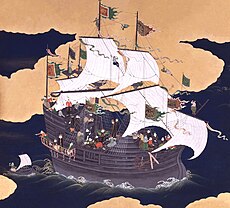
From the time of the acquisition ofMacauin 1557, and their formal recognition as trade partners by the Chinese, the Portuguese started to regulate trade to Japan, by selling to the highest bidder the annual "captaincy" (ito wappu) to Japan, in effect conferring exclusive trading rights for a singlecarrackbound for Japan every year. The carracks were very large ships, usually between 1000 and 1500 tons, about double or triple the size of a largegalleonorjunk.
That trade continued with few interruptions until 1638, when it was prohibited on the grounds that the priests and missionaries associated with the Portuguese traders were perceived as posing a threat to the shogunate's power and the nation's stability.
Portuguese trade was progressively more and more challenged by Chinese smugglers, JapaneseRed Seal Shipsfrom around 1592 (about ten ships every year), Spanish ships fromManilafrom around 1600 (about one ship a year), the Dutch from 1609, and the English from 1613 (about one ship per year). Some Japanese are known to have travelled abroad on foreign ships as well, such asChristopher and Cosmaswho crossed the Pacific on a Spanish galleon as early as 1587, and then sailed to Europe withThomas Cavendish.
The Dutch, who, rather thanNanbanwere calledKōmō(Hồng mao),lit. "Red Hair" by the Japanese, first arrived in Japan in 1600, on board theLiefde.Their pilot wasWilliam Adams,the first Englishman to reach Japan. In 1605, two of theLiefde's crew were sent toPattanibyTokugawa Ieyasu,to invite Dutch trade to Japan. The head of the Pattani Dutch trading post,Victor Sprinckel,refused on the grounds that he was too busy dealing with Portuguese opposition in Southeast Asia. In 1609, however, the DutchmanJacques Specxarrived with two ships inHirado,and through Adams obtained trading privileges from Ieyasu.
The Dutch also engaged in piracy and naval combat to weaken Portuguese and Spanish shipping in the Pacific, and ultimately became the only Westerners to be allowed access to Japan. For two centuries beginning in 1638, they were restricted to the island ofDejimainNagasakiharbor.
Invasions of Korea and the Ryūkyūs[edit]
In 1592 and again in 1598,Toyotomi Hideyoshiorganized invasions of Korea using some 9,200 ships.[8]From the beginning of the War in 1592, the supreme commander of Hideyoshi's fleet wasKuki Yoshitaka,whose flagship was the 33 meter-longNihonmaru.Subordinate commanders includedWakisaka YasuharuandKatō Yoshiaki.After their experience in theŌei Invasionand other operations against Japanese pirates, the Chinese and Korean navies were more skilled than the Japanese. They relied throughout upon large numbers of smaller ships whose crews would attempt to board the enemy. Boarding was the main tactic of almost all navies until the modern era, and Japanese samurai excelled in close combat. The Japanese commonly used many light, swift, boarding ships calledKobayain an array that resembled a rapid school of fish following the leading boat. This tactic's advantage was that once they succeeded in boarding one ship, they could hop aboard other enemy ships in the vicinity, in a wildfire fashion.
Japanese ships at the time were built with wooden planks and steel nails, which rusted in seawater after some time in service. The ships were built in a curved pentagonal shape with light wood for maximum speeds for their boarding tactics, but it undermined their capability to quickly change direction. Also, they were somewhat susceptible to capsizing in choppy seas and seastorms. The hulls of Japanese ships were not strong enough to support the weight and recoil of cannons. Rarely did Japanese ships have cannons, and those that did usually hung them from overhead beams with ropes and cloth. Instead, the Japanese relied heavily on their muskets and blades.
The Korean Navy attacked a Japanese transportation fleet effectively and caused extensive damage.Won GyunandYi Sun-sinat theBattle of Okpohas destroyed the Japanese convoy, and their failure enabled Korean resistance inJeollaprovince, in the south-east of Korea, to continue.Wakisaka Yasuharuwas ordered to dispatch a 1,200 man navy during the Keicho Invasion and annihilated the invading Korean navy led by Won Kyun during a counterattack in July 1597 (Battle of Chilcheollyang). Korean AdmiralYi EokgiandWon Gyunof Korea were killed in this combat.Hansan Islandwas occupied by Japan, consolidating the Japanese hold on the west coast of Korea. To prevent Japan from invading China by way of the Korean peninsula west coast, China sent naval forces.[9]
In August 1597, the Japanese Navy was ordered to occupy theJeolla.[10]In theBattle of Myeongnyang,the Joseon fleet inflicted huge damage on the Japanese fleet. The Japanese were unable to counterattack even after the Joseon made a strategic withdrawal to the northern side ofJeollaprovince. While the Japanese navy had made a few minor incursions along the southwestern coast ofJeollaprovince, including the capture ofGang Hang,they ultimately failed to occupyJeollaprovince by the end of the war. Remnants of the Korean navy led by Yi Sun-sin joined the Ming Chinese fleet underChen Lin's forces and continued to attack Japanese supply lines. Towards the end of the war, as the remaining Japanese tried to withdraw from Korea, they were beset by Korean and Chinese forces.[11]To rescue his comrades,Shimazu Yoshihiroattacked the allied fleet. At theBattle of Noryang,the Shimazu defeated Chinese generalChen Linand Japanese forces succeeded in escaping the Korean Peninsula[12][13]Yi Sun-sin was killed in this action.[14]
Japan's failure to gain control of the sea, and their resulting difficulty in resupplying troops on land, was one of the major reasons for the invasion's ultimate failure. After the death of Hideyoshi, the main proponent of the invasion, the Japanese ceased attacks on Korea.
Invasion of the Ryūkyūs[edit]
In 1609,Shimazu Tadatsune,Lord ofSatsuma,invaded the southern islands ofRyūkyū(modernOkinawa) with a fleet of 13 junks and 2,500samurai,thereby establishingsuzeraintyover the islands. They faced little opposition from the Ryukyuans, who lacked any significant military capabilities, and who were ordered by KingShō Neito surrender peacefully rather than suffer the loss of precious lives.[15]
Oceanic trade (16th–17th century)[edit]
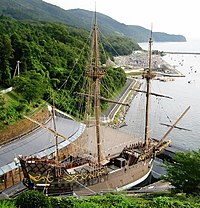
Japan built her first large ocean-going warships at the beginning of the 17th century, following contacts with the Western nations during theNanban trade period.
William Adams[edit]
In 1604,ShōgunTokugawa Ieyasu ordered William Adams and his companions to build Japan's first Western-style sailing ship atItō,on the east coast of theIzu Peninsula.An 80-ton vessel was completed and theshōgunordered a larger ship, 120 tons, to be built the following year (both were slightly smaller than theLiefde,the ship in which William Adams came to Japan, which was 150 tons). According to Adams, Ieyasu "came aboard to see it, and the sight whereof gave him great content". The ship, namedSan Buena Ventura,was lent to shipwrecked Spanish sailors for their return to Mexico in 1610.
Hasekura Tsunenaga[edit]
In 1613, thedaimyōofSendai,in agreement with theTokugawa shogunate,built theDate Maru,a 500-tongalleon-type ship that transported a Japanese embassy to the Americas, and then continued to Europe.
Red Seal ships[edit]
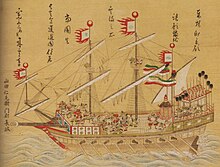
From 1604, about 350Red seal ships,usually armed and incorporating some Western technologies, were authorized by the shogunate, mainly forSoutheast Asiantrade. Japanese ships and samurai helped in the defense ofMalaccaon the side of the Portuguese against theDutch AdmiralCornelis Mateliefin 1606. Several armed ships of the Japanese adventurerYamada Nagamasawould play a military role in the wars and court politics ofSiam.William Adams, who participated in the Red Seal ship trade, would comment that"the people of this land (Japan) are very stout seamen".
Planned invasion of the Philippines[edit]
The Tokugawa shogunate had, for some time, planned to invade thePhilippinesin order to eradicate Spanish expansionism in Asia, and its support of Christians within Japan. In November 1637 it notified Nicolas Couckebacker, the head of theDutch East India Companyin Japan, of its intentions. About 10,000 samurai were prepared for the expedition, and the Dutch agreed to provide four warships and two yachts to support the Japanese ships against Spanish galleons. The plans were cancelled at the last minute with the advent of the ChristianShimabara Rebellionin Japan in December 1637.[16] [17]
Seclusion (1640–1840)[edit]

The Dutch's cooperation on these, and other matters, would help ensure they were the only Westerners allowed in Japan for the next two centuries. Following these events, the shogunate imposed a system ofmaritime restrictions( cấm biển,kaikin), which forbade contacts with foreigners outside of designated channels and areas, bannedChristianity,and prohibited the construction of ocean-going ships on pain of death. The size of ships was restricted by law, and design specifications limiting seaworthiness (such as the provision for a gaping hole in the aft of the hull) were implemented. Sailors who happened to be stranded in foreign countries were prohibited from returning to Japan on pain of death.
A tiny Dutch delegation in Dejima, Nagasaki was the only allowed contact with the West, from which the Japanese were kept partly informed of western scientific and technological advances, establishing a body of knowledge known asRangaku.Extensive contacts with Korea and China were maintained through theTsushima Domain,the Ryūkyū Kingdom under Satsuma's dominion, and the trading posts at Nagasaki. TheMatsumae Domainon Hokkaidō managed contacts with the nativeAinu peoples,and withImperial Russia.
Many isolated attempts to end Japan's seclusion were made by expanding Western powers during the 19th century. American, Russian and French ships all attempted to engage in relationship with Japan, but were rejected.
These largely unsuccessful attempts continued until, on July 8, 1853, CommodoreMatthew Perryof theU.S. Navywith fourwarships:Mississippi,Plymouth, Saratoga,andSusquehannasteamed into the Bay of Edo (Tokyo) and displayed the threatening power of his ships'Paixhansguns.He demanded that Japan open to trade with the West. These ships became known as thekurofune,orBlack Ships.
Barely one month after Perry, the Russian AdmiralYevfimy Putyatinarrived in Nagasaki on August 12, 1853. He made a demonstration of a steam engine on his ship thePallada,which led to Japan's first manufacture of a steam engine, created byTanaka Hisashige.
The following year, Perry returned with seven ships and forced theshōgunto sign the "Treaty of Peace and Amity", establishing formal diplomatic relations between Japan and the United States, known as theConvention of Kanagawa(March 31, 1854). Within five years Japan had signed similar treaties with other western countries. TheHarris Treatywas signed with the United States on July 29, 1858. These treaties were widely regarded by Japanese intellectuals as unequal, having been forced on Japan throughgunboat diplomacy,and as a sign of the West's desire to incorporate Japan into theimperialismthat had been taking hold of the continent. Among other measures, they gave the Western nations unequivocal control of tariffs on imports and the right ofextraterritorialityto all their visiting nationals. They would remain a sticking point in Japan's relations with the West up to the start of the 20th century.
Modernization: Bakumatsu period (1853–1868)[edit]

The study of Westernshipbuildingtechniques resumed in the 1840s. This process intensified along with the increased activity of Western shipping along the coasts of Japan, due to the China trade and the development ofwhaling.
From 1852, the government of theshōgun(theLate Tokugawa shogunateor "Bakumatsu" ) was warned by theNetherlandsof the plans ofCommodore Perry.Three months after Perry's first visit in 1853, the Bakufu cancelled the law prohibiting the construction of large ships ( thuyền lớn kiến tạo cấm lệnh ), and started organizing the construction of a fleet of Western-style sail warships, such as theHōō Maru,theShōhei Maruor theAsahi Maru,usually asking each fief to build their own modern ships. These ships were built usingDutchsailing manuals, and the know-how of a few returnees from the West, such asNakahama Manjirō.Also with the help of Nakahama Manjirō, theSatsumafief built Japan's first steam ship, theUnkoumaru( vân hành hoàn ) in 1855.[18] The Bakufu also established defensive coastal fortifications, such as atOdaiba.
[edit]
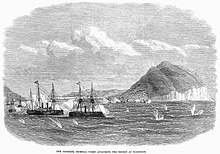
As soon as Japan agreed to open up to foreign influence, theTokugawashōgungovernment initiated an active policy of assimilation of Western naval technologies. In 1855, with Dutch assistance, the shogunate acquired its first steam warship, theKankō Maru,which was used for training, and established theNagasaki Naval Training Center.In 1857, it acquired its first screw-driven steam warship, theKanrin Maru.
In 1860, theKanrin Maruwas sailed to the United States by a group of Japanese, with the assistance of a single US Navy officerJohn M. Brooke,to deliver the first Japanese embassy to the United States.
Naval students were sent abroad to study Western naval techniques. The Bakufu had initially planned on ordering ships and sending students to the United States, but theAmerican Civil Warled to a cancellation of plans. Instead, in 1862 the Bakufu placed its warship orders with the Netherlands and decided to send 15 trainees there. The students, led byUchida Tsunejirō( nội điền hằng thứ lang ), leftNagasakion September 11, 1862, and arrived inRotterdamon April 18, 1863, for a stay of 3 years. They included such figures as the future AdmiralEnomoto Takeaki,Sawa Tarosaemon( trạch quá lang tả vệ môn ),Akamatsu Noriyoshi( xích tùng tắc lương ),Taguchi Shunpei( điền khẩu tuấn bình ),Tsuda Shinichiro( tân điền thật một lang ) and the philosopherNishi Amane.This started a tradition of foreign-educated future leaders such AdmiralsTōgōand, later,Yamamoto.
In 1863, Japan completed her first domestically built steam warship, theChiyodagata,a 140-tongunboatcommissioned into the Tokugawa Navy (Japan's first steamship was the Unkoumaru - vân hành hoàn - built by the fief ofSatsumain 1855). The ship was manufactured by the future industrial giant,Ishikawajima,thus initiating Japan's efforts to acquire and fully develop shipbuilding capabilities.
Following the humiliations at the hands of foreign navies in theBombardment of Kagoshimain 1863, and theBattle of Shimonosekiin 1864, the shogunate stepped up efforts to modernize, relying more and more on French and British assistance. In 1865, the French naval engineerLéonce Vernywas hired to build Japan's first modern naval arsenals, atYokosukaandNagasaki.More ships were imported, such as theJho Sho Maru,theHo Sho Maruand theKagoshima,all commissioned byThomas Blake Gloverand built inAberdeen.
By the end of the Tokugawa shogunate in 1867, the Japanese navy already possessed eight Western-style steam warships around the flagshipKaiyō Maruwhich were used against pro-imperial forces during theBoshin War,under the command of AdmiralEnomoto.The conflict culminated with theNaval Battle of Hakodatein 1869, Japan's first large-scale modern naval battle.
In 1869, Japan acquired its first ocean-going ironclad warship, theKōtetsu,ordered by the Bakufu but received by the new Imperial government, barely ten years after such ships were first introduced in the West with the launch of the FrenchLa Gloire.
[edit]

TheImperial Japanese Navy(IJN) (Japanese:Đại Nhật Bản đế quốc hải quân) was thenavyof Japan between 1868 and until 1945, when it wasdissolvedfollowing Japan'sdefeat and surrender in World War II.
From 1868, the restoredMeiji Emperorcontinued with reforms to industrialize and militarize Japan in order to prevent it from being overwhelmed by the United States and European powers. The Imperial Japanese Navy was formally established in 1869. The new government drafted a very ambitious plan to create a Navy with 200 ships, organized into 10 fleets, but the plan was abandoned within a year due to lack of resources. Internally, domestic rebellions, and especially theSatsuma Rebellion(1877) forced the government to focus on land warfare. Naval policy, expressed by the sloganShusei Kokubō(Thủ thế quốc phòng,"Static Defense" ), focused on coastal defenses, a standing army, and a coastal Navy, leading to a military organization under theRikushu Kaiju(Jp: Lục chủ hải 従, Army first, Navy second) principle.
During the 1870s and 1880s, the Japanese Navy remained an essentially coastal defense force, although the Meiji government continued to modernize it. In 1870 an Imperial decree determined that the Royal Navy should be the model for development, and the second British naval mission to Japan, the Douglas Mission (1873–79) led byArchibald Lucius Douglaslaid the foundations of naval officer training and education. (See Ian Gow, 'The Douglas Mission (1873–79) and Meiji Naval Education' in J. E. Hoare ed.,Britain & Japan: Biographical Portraits Volume III,Japan Library 1999.)Tōgō Heihachirōwas trained by the Royal Navy.
During the 1880s, France took the lead in influence, due to its "Jeune École" doctrine favoring small, fast warships, especiallycruisersandtorpedo boats,against bigger units. The Meiji government issued its First Naval Expansion bill in 1882, requiring the construction of 48 warships, of which 22 were to be torpedo boats. The naval successes of theFrench Navyagainst China in theSino-French Warof 1883–85 seemed to validate the potential of torpedo boats, an approach which was also attractive to the limited resources of Japan. In 1885, the new Navy slogan becameKaikoku Nippon(Hải Quốc Nhật Bản,"Maritime Japan" ).
In 1886, the leading French Navy engineerÉmile Bertinwas hired for four years to reinforce the Japanese Navy, and to direct the construction of the arsenals ofKureandSasebo.He developed theSankeikanclass of three cruisers, which are named afterThree Views of Japan,featuring a single but powerful main gun, the 12.6 inch Canet gun.
This period also allowed Japan to adopt new technologies such as torpedoes, torpedo-boats and mines, which were actively promoted by the French Navy (Howe, p281). Japan acquired its first torpedoes in 1884, and established a "Torpedo Training Center" at Yokosuka in 1886.
Sino-Japanese War[edit]
Japan continued the modernization of its navy, especially as China was also building a powerful modern fleet with foreign, especially German, assistance, and the pressure was building between the two countries to take control of Korea. TheSino-Japanese warwas officially declared on August 1, 1894, though some naval fighting had already taken place.
The Japanese navy devastated Qing's northern fleet off the mouth of theYalu Riverat theBattle of Yalu Riveron September 17, 1894, in which the Chinese fleet lost 8 out of 12 warships. Although Japan turned out victorious, the two large German-made battleships of the Chinese Navy remained almost impervious to Japanese guns, highlighting the need for bigger capital ships in the Japanese Navy (theTing Yuanwas finally sunk by torpedoes, and theChen-Yuanwas captured with little damage). The next step of the Imperial Japanese Navy's expansion would thus involve a combination of heavily armed large warships, with smaller and innovative offensive units permitting aggressive tactics.
The Imperial Japanese Navy further intervened in China in 1900, by participating together with Western Powers to the suppression of the ChineseBoxer Rebellion.The Navy supplied the largest number of warships (18, out of a total of 50 warships), and delivered the largest contingent of Army and Navy troops among the intervening nations (20,840 soldiers, out of total of 54,000).
Russo-Japanese War[edit]


Following theFirst Sino-Japanese War,and the humiliation of the forced return of theLiaotung peninsulato China under Russian pressure (the "Triple Intervention"), Japan began to build up its military strength in preparation for further confrontations. Japan promulgated a ten-year naval build-up program, under the slogan" Perseverance and determination "(Jp: Nằm gai nếm mật, Gashinshoutan), in which it commissioned 109 warships, for a total of 200,000 tons, and increased its Navy personnel from 15,100 to 40,800.
These dispositions culminated with theRusso-Japanese War(1904–1905). TheJapanese battleship Mikasawas the flagship of AdmiralTōgō Heihachirō.At theBattle of Tsushima,the Mikasa led the combined Japanese fleet into what has been called "the most decisive naval battle in history".[8]The Russian fleet was almost completely annihilated: out of 38 Russian ships, 21 were sunk, 7 captured, 6 disarmed, 4,545 Russian servicemen died and 6,106 were taken prisoner. On the other hand, the Japanese only lost 117 men and 3 torpedo boats.
World War II[edit]

In the years before World War II the IJN began to structure itself specifically to fight the United States. A long stretch ofmilitaristicexpansion and the start of theSecond Sino-Japanese Warin 1937 had alienated the United States, and the country was seen as a rival of Japan.
To achieve Japan's expansionist policies, the Imperial Japanese Navy also had to fight off the largest navies in the world (The 1922Washington Naval Treatyallotted a 5/5/3 ratio for the navies of Great Britain, the United States and Japan). She was therefore numerically inferior and her industrial base for expansion was limited (in particular compared to the United States). Her battle tactics therefore tended to rely on technical superiority (fewer, but faster, more powerful ships), and aggressive tactics (daring and speedy attacks overwhelming the enemy, a recipe for success in her previous conflicts). The Naval Treaties also provided an unintentional boost to Japan because the numerical restrictions on battleships prompted them to build more aircraft carriers to try to compensate for the United States' larger battleship fleet[citation needed].
The Imperial Japanese Navy was administered by the Ministry of the Navy of Japan and controlled by the Chief of the Imperial Japanese Navy General Staff at Imperial General Headquarters. In order to combat the numerically superior American navy, the IJN devoted large amounts of resources to creating a force superior in quality to any navy at the time. Consequently, at the beginning ofWorld War II,Japan probably had the most sophisticated Navy in the world.[9]Betting on the speedy success of aggressive tactics, Japan did not invest significantly on defensive organization such as protecting her long shipping lines against enemy submarines, which she never managed to do, particularly under-investing inanti-submarineescort ships andescort aircraft carriers.
The Japanese Navy enjoyed spectacular success during the first part of the hostilities, but American forces ultimately managed to gain the upper hand through decrypting theJapanese naval codes,exploiting the aforementioned Japanese neglect of fleet defense, technological upgrades to its air and naval forces, superior personnel management such as routinely reassigning accomplished combat pilots to provide experienced training of new recruits, and a vastly stronger industrial output. Japan's reluctance to use theirsubmarinefleet for commerce raiding and failure to secure their communications also added to their defeat. During the last phase of the war the Imperial Japanese Navy resorted to a series of desperate measures, includingKamikaze(suicide) actions, which ultimately not only proved futile in repelling the Allies, but encouraged those enemies to use their newly developedatomic bombsto defeat Japan without the anticipated costly battles against so fanatical a defence.
Maritime Self-Defense Force[edit]

Following Japan's surrender to the Allied Forces at the conclusion ofWorld War II,and the subsequentallied occupation,Japan's entire imperial military was dissolved with the1947 constitution.The constitution states "The Japanese people forever renounce war as a sovereign right of the nation and the threat or use of force as a means of settling international disputes." Japan only had a National Security Force and was totally reliant on the US for protection. However, by 1954 theSelf-Defense Forces Act (Act No. 165 of 1954)reorganized the National Security Force as theJapan Ground Self-Defense Force(GSDF) and The Coastal Safety Force was reorganized as theJapan Maritime Self-Defense Force(JMSDF), the de facto JapaneseNavy.[19][20]TheJapan Air Self-Defense Force(JASDF) was established as a new branch of the JSDF. GeneralKeizō Hayashiwas appointed as the first Chairman of Joint Staff Council—professional head of the three branches.[21]Its offensive capabilities are still restricted due to the nation's constitution.
The post-warJapanese economic miracleenabled Japan to regaingreat powerand leadingMaritime powerstatus.[22][23][24]By 1992, the Maritime Self-Defense Force (MSDF) had an authorized strength of 46,000 and maintained some 44,400 personnel and operated 155 major combatants, including thirteen submarines, sixty-four destroyers and frigates, forty-three mine warfare ships and boats, eleven patrol craft, and six amphibious ships. It also flew some 205 fixed-wing aircraft and 134 helicopters. Most of these aircraft were used in antisubmarine and mine warfare operations. By 2015, theJSDFwas ranked byCredit Suisseas the 4th most powerful military in the world.[1]
See also[edit]
- Strike South Group
- Fleet Faction– Navy political group
- Treaty Faction– Navy political group
- May 15 Incident– coup d'état with Navy support
- Imperial Way Faction
- Japanese nationalism
References[edit]
- Boxer, C. R. (1993) "The Christian Century in Japan 1549–1650",ISBN1-85754-035-2
- Delorme, Pierre,Les Grandes Batailles de l'Histoire, Port-Arthur 1904,Socomer Editions (French)
- Dull, Paul S. (1978)A Battle History of The Imperial Japanese NavyISBN0-85059-295-X
- Evans, David C. &Peattie,Mark R. (1997)Kaigun: strategy, tactics, and technology in the Imperial Japanese Navy, 1887–1941Naval Institute Press, Annapolis, MarylandISBN0-87021-192-7
- Gardiner, Robert (editor) (2001)Steam, Steel and Shellfire, The Steam Warship 1815–1905,ISBN0-7858-1413-2
- Howe, Christopher (1996)The origins of Japanese Trade Supremacy, Development and technology in Asia from 1540 to the Pacific War,The University of Chicago PressISBN0-226-35485-7
- Ireland, Bernard (1996)Jane's Battleships of the 20th CenturyISBN0-00-470997-7
- Lyon, D. J. (1976)World War II warships,Excalibur BooksISBN0-85613-220-9
- Nagazumi, Yōko ( vĩnh tích dương tử )Red Seal Ships ( chu ấn thuyền ),ISBN4-642-06659-4(Japanese)
- Tōgō Shrine and Tōgō Association ( đông hương thần xã ・ đông hương sẽ ),Togo Heihachiro in images, illustrated Meiji Navy( đồ nói đông hương bình tám lang, mục で thấy る minh trị の hải quân ), (Japanese)
- Japanese submarinesLặn xuống nước hạm đại tác phẩm chiến, Jinbutsu publishing ( tân nhân vật 従 tới xã ) (Japanese)
Notes[edit]
- ^abO’Sullivan, Michael; Subramanian, Krithika (2015-10-17).The End of Globalization or a more Multipolar World?(Report).Credit SuisseAG. Archived fromthe originalon 2018-02-15.Retrieved2017-07-14.
- ^abCampbell, Allen; Nobel, David S (1993).Japan: An Illustrated Encyclopedia.Kodansha. p. 1186.ISBN406205938X.
- ^Joanna Rurarz (2014).Historia Korei(in Polish). Wydawnictwo Akademickie Dialog. p. 89.ISBN9788363778866.
- ^Andriyenko, L (15 March 2011)."The Azumi Basin in Japan and Its Ancient People".Web Archive.Archivedfrom the original on 2013-12-31.Retrieved18 May2020.
- ^abRambelli, F (2018).The Sea and The Sacred in Japan.Camden: Bloomsbury Academic Publishing. pp. preface.ISBN978-1350062870.
- ^Grapard, Allan G. (1993).The Protocol of the Gods: A Study of the Kasuga Cult in Japanese History.University of California Press. p. 32.ISBN9780520910362.Retrieved25 May2020.
- ^Palmer, E (2015).Harima Fudoki: A Record of Ancient Japan Reinterpreted, Translated, Annotated with Commentary.Leiden: Brill. p. 144.ISBN978-9004269378.
- ^Nagoya UniversityThe Naval Organization in the Korean Expedition of the Toyotomi Régime
- ^History of Ming( liệt truyện 200 tám ngoại quốc một Triều Tiên ) Vol.208Korea[1]Archived2012-06-26 at theWayback Machine[2]Archived2012-06-26 at theWayback Machine"Vạn lịch 25 năm (1597) bảy tháng (July)" bảy tháng, Oa đoạt Lương Sơn, tam lãng, toại nhập Khánh Châu, xâm nhàn sơn. Đêm tập cung sơn đảo, thống nhất quản lýNguyên đềuThịnh hành, toại thất nhàn sơn yếu hại. Nhàn sơn đảo ở Triều Tiên Tây Hải khẩu, hữu chướng nam nguyên, vì toàn la ngoại phiên. Một thất thủ tắc vùng duyên hải vô bị, Thiên Tân, đăng lai đều có thể giương buồm tới. Mà ta thuỷ binh 3000, phủ để lữ thuận.
- ^[3]Archived2012-04-15 at theWayback MachineJapanese History Laboratory, Faculty of Letters,Kobe University
- ^“Chinh Hàn lục (Sei-kan-roku)” (Public Record of Shimazu clan that Shimazu Hiromichi( đảo tân lâu thông ) wrote in 1671) quyển sáu (Vol6) "Nhật Bản の quân binh tất く thảo quả すべき の khi đến れりと duyệt んで, tức phó tổng binh trần tằm ・ quách tử long ・ du kích mã văn gọi ・ Lý kim ・ trương lương tướng chờ に tương kế て, lục binh 5000, thuỷ binh 3000 を sư ゐ, Triều Tiên の đại tướng Lý thống nhất quản lý, Thẩm lý が thế を hợp わせ, lẫn nhau đều hợp nhất vạn 3000 dư binh, toàn la nói thuận lòng trời の cửa biển cổ kim と vân sở に trận し, chiến hạm mấy trăm con を nghĩ ひして, gì dạng một chiến に công lớn をなすべきと đãi huyền たり."
- ^History of Ming( liệt truyện 200 tám ngoại quốc một Triều Tiên ) Vol.208Korea[4]Archived2012-06-26 at theWayback Machine"Thạch mạn tử (Shimazu) dẫn thuyền sư cứu hành trường (Konishi Yukinaga), trần lân (Chen Lin) chặn đánh bại chi"
- ^“Chinh Hàn lục (Sei-kan-roku)” quyển sáu (Vol6) "Ngoại lập hoa ・ chùa trạch ・ tông ・ cao kiều thị の quân binh, hỏa hoa を tán して tương chiến ひける gian に năm gia の mặt 々は, thuận lòng trời の thành を chạy ra, Nam Hải の ngoại hải を hồi りて rút lui く.".
- ^NaverBattle of Noryang - Dusan EnCyber
- ^Kerr, George H. (2000). Okinawa: the History of an Island People. (revised ed.) Boston: Tuttle Publishing.
- ^Turnbull, Stephen R. (1996).The Samurai: a military history.Routledge. p. 260.ISBN1-873410-38-7.
- ^Murdoch, James (2004).A History of Japan.Routledge. p. 648.ISBN0-415-15416-2.
- ^Technology of edoISBN4-410-13886-3,p37
- ^Takei, Tomohisa(2008)."Japan Maritime Self Defense Force in the New Maritime Era"(PDF).Hatou.34:3. Archived fromthe original(PDF)on 15 December 2018.
- ^Võ cư trí lâu(2008).Hải dương tân thời đại における trên biển tự vệ đội[Japan Maritime Self Defense Force in the New Maritime Era](PDF).Sóng gió(in Japanese).34.Sóng gió biên tập ủy ban: 5. Archived fromthe original(PDF)on 15 December 2018.
- ^"Japan Self-Defense Force | Defending Japan".Defendingjapan.wordpress.Retrieved2014-08-03.
- ^"The Seven Great Powers".American-Interest.RetrievedJuly 1,2015.
- ^T. V. Paul; James J. Wirtz; Michel Fortmann (2005)."Great+power" &pg=PA59Balance of Power.United States of America: State University of New York Press, 2005. pp. 59, 282.ISBN0-7914-6401-6.Accordingly, the great powers after the Cold War are Britain, China, France, Germany, Japan, Russia, and the United Statesp.59
- ^Baron, Joshua (January 22, 2014).Great Power Peace and American Primacy: The Origins and Future of a New International Order.United States: Palgrave Macmillan.ISBN978-1-137-29948-2.
- ^Video footage of the Sino-Japanese war:Video (external link)Archived2016-08-26 at theWayback Machine.
- ^:Ngụy lược: “Oa nhân tự gọi quá bá lúc sau.” / tấn thư: “Tự gọi quá bá lúc sau, lại ngôn thượng cổ sử nghệ Trung Quốc, toàn tự xưng đại phu.” Liệt truyện thứ 67 bốn di / tư trị thông giam: “Hôm nay bổn lại vân ngô quá bá lúc sau, cái ngô vong, này chi thứ nhập hải vì Oa.”
- ^NagazumiRed Seal Ships,p21
- ^THE FIRST IRONCLADSIn Japanese:[10],[11].Also in English:[12]Archived2019-11-17 at theWayback Machine:"Iron clad ships, however, were not new to Japan and Hideyoshi;Oda Nobunaga,in fact, had many iron clad ships in his fleet. "(referring to the anteriority of Japanese ironclads (1578) to the KoreanTurtle ships(1592)). In Western sources, Japanese ironclads are described in CR Boxer "The Christian Century in Japan 1549-1650", p122, quoting the account of the Italian Jesuit Organtino visiting Japan in 1578. Nobunaga's ironclad fleet is also described in "A History of Japan, 1334-1615", Georges Samson, p309ISBN0-8047-0525-9.Korea's "ironclad Turtle ships" were invented by AdmiralYi Sun-sin(1545–1598), and are first documented in 1592. Incidentally, Korea's iron plates only covered the roof (to prevent intrusion), and not the sides of their ships. The first Western ironclads date to 1859 with the FrenchGloire( "Steam, Steel and Shellfire" ).
- ^CorbettMaritime Operations in the Russo-Japanese War,2:333
- ^Howe, p286


